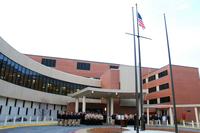Top Navy leaders continue to insist they need a fleet of 355 ships to carry out contingency operations around the globe. But at the same time, they are looking forward to a near future where the number of gray hulls may not be the best way to measure naval strength.
In coming weeks, the Navy will release a document laying out what leaders see as the future of the service, Chief of Naval Operations Adm. John Richardson said during a discussion at the Brookings Institution in Washington, D.C., on Thursday. It will discuss not only how to pursue a fleet ramp-up in a cash-strapped reality, but also how innovation can allow the service to get more capability out of available platforms.
"Let's talk about the equivalent capability of 355 ships with some of these new innovative technologies that are really right around the corner, knocking on the door," Richardson said. " ... We should be coming up with something compelling in the next couple weeks."
Richardson's remarks come days after the Congressional Budget Office released an assessment finding that the construction costs to reach a 355-ship Navy from the current fleet of 275 ships would average $26.6 billion per year, some 60 percent more than the service has averaged on shipbuilding over the last three decades.
The Navy's strategy, he said, "[has] got to be mindful of the resources that are available. That's our challenge."
A defense official with knowledge of the planned document said it would seek, among other things, to provide an internal measure of naval capability apart from numbers of ships. Unmanned platforms, in particular, may enable the Navy to expand capability and move beyond the metric of manned hull strength.
"I think [Richardson] would sacrifice numbers to have capabilities out there," the official said.
But whether the Navy will at any point be able to refine its ship requirement down has yet to be seen.
"There's almost unanimous consensus the future security environment is going to demand more Navy, a bigger Navy," Richardson said. "But I'll tell you what, if I build 355 of today's ships and operate under today's concepts and project them forward to the mid 2020s, that's probably not the force that's going to be decisive and able to protect America from attack and promote our interests around the world. So it really is a combination of both."








